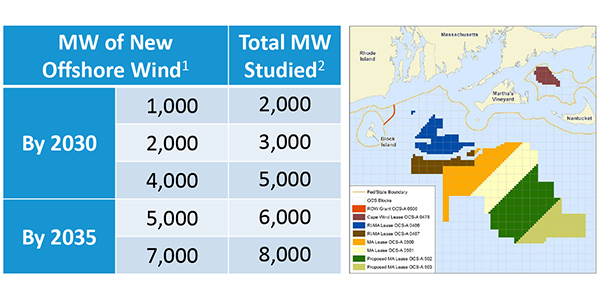About 5,800 MW of offshore wind can be interconnected using AC cable connections to interconnection points along the southern New England coast without significant upgrades to the onshore transmission network, according to ISO-NE’s 2019 Economic Study Offshore Wind Transmission Interconnection Analysis.
ISO-NE Director of Transmission Services and Resource Qualification Al McBride presented the analysis, which noted that some local 345-kV reinforcement and/or expansion is still likely to be needed for this scenario, and that additional interconnections to these points would drive the need for significant network upgrades.
The New England States Committee on Electricity (NESCOE), Anbaric Development Partners and RENEW Northeast last year each requested separate studies from ISO-NE. (See “Modeling More Offshore Wind, Slowly,” ISO-NE Planning Advisory Committee: March 18, 2020.)
Alternatively, additional offshore wind could be connected while avoiding significant onshore transmission upgrades by using HVDC connections from the offshore wind farms to load center substations, McBride said.
Anbaric has proposed the Southern New England Ocean Grid, an open-access, 1,200-MW HVDC network that would interconnect future offshore wind projects in the federal wind lease area off the coasts of Rhode Island and Massachusetts.
Such an undersea network interconnecting an expected surge in offshore wind projects would save New England developers and ratepayers more than $1 billion in onshore grid upgrades, The Brattle Group said in a study commissioned by Anbaric. (See Brattle Study Highlights Benefits of Offshore Grid.)
“There are also potentially hybrids, where you go part of the way with AC, part of the way with DC, or the other way around,” McBride said.
“Just to compare the alternatives, for what we call the AC alternative, you are continuing to add a lot of cable to the water,” he said.
The study also determined that 2,200 MW could be connected using HVDC without major onshore transmission upgrades, which, in addition to the 5,800 MW connected using AC cables, provides a total of 8,000 MW of connected offshore wind off the southern New England coast.
No Public Policy Tx Need
Director of Transmission Planning Brent Oberlin reviewed the steps ISO-NE took in the 2020 Public Policy Transmission Upgrade process that concluded there was no need to proceed with a Public Policy Transmission Study (PPTS) this year.
The RTO agreed with NESCOE’s position that none of the stakeholder submittals regarding public policy requirements identified a federal law that drives a transmission need and said it is not aware of any such requirements that drive the need for transmission.
Similarly, the RTO reviewed NESCOE’s submittal and found that the states have determined that there are currently no state or local requirements that drive transmission that should be studied in a PPTS.




